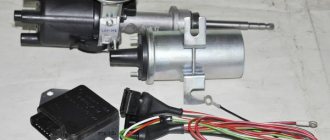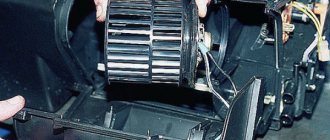Why is additional heating needed?
When storing a car in open parking lots, the metal body of the car quickly cools down. The inside of the glass is covered with a thin layer of condensation, which later turns into an ice crust. Within a few hours of parking, almost all parts, including all rows of seats, reach ambient temperature.
Heating adjustment from the passenger compartment
In the morning, the driver tries to quickly bring a cold car to normal temperature, but for such a stressful state of the car, one stove will not be enough . Even if you start driving in a poorly warmed car, you can wait more than one hour for it to reach normal temperature conditions.
If, from the very beginning, all the heat is taken from a cold car to heat the interior, then there will not be enough heat for the engine to return to normal temperature conditions, which means that the power plant will have less and less heat for the interior and will not be able to do without an additional heater.
A frozen driver is ineffective at driving. He is stressed and may lose attention and control of the road. This can lead to emergency situations.
Additional radiator
Very often, motorists solve the problem of heating the vehicle interior with the help of another radiator and fan. It is connected to the standard heater, for which additional pipes are installed in the passenger compartment. This solution is quite common for the interiors of passenger minibuses, buses and vans, which have a large volume.
Autonomous heaters for minibuses
The advantages include:
- standard operating principle;
- efficient and fast heating;
- the ability to select a profitable option in any auto store;
- lower cost than analogues.
The disadvantages of this option are:
- the need for proper installation;
- heating efficiency depends on the degree of engine warm-up;
- additional consumables are required - hoses, tubes, insulating materials;
- interference with the appearance of the interior;
- there are no guarantees that the desired effect from the installation will be achieved;
- the volume of coolant increases.
Popular models of autonomous car heaters
We list the most popular devices, the operation of which requires connection to the on-board power supply:
- Planar 4D is an air-type heater that runs on diesel fuel. The 4 kW model allows you to regulate both the temperature and the speed of the air flow supplied to the cabin. Modification 4D-12, as the name suggests, is suitable for use in passenger cars, since it requires connection to a 12-volt battery. A more productive modification, Planar 4D-24, runs on 24-volt batteries and therefore can be used to heat buses and heavy trucks, as well as special equipment. Electricity consumption is at the level of 4 A/h, which is quite acceptable when using a battery with a capacity of 150 A/h. The cost of the heater is from 190,000 rubles;
- Webasto AIR TOP 02000ST is a series of popular air-type autonomous heaters from a well-known global manufacturer of automotive components. With a thermal power of 2 kW, these devices can operate on several types of fuel. It is possible to adjust the temperature and air flow speed. Electricity consumption, as in the previous case, is 4 A/h, so if used in a passenger car, it is recommended to install an additional battery with a capacity of 75 A/h. The average cost of heaters of this series is 450,000 rubles;
- Hydronic B04W SC is one of the few popular representatives of liquid-type heaters, which is often used as a pre-heater. It runs on gasoline, the thermal power of the device is 4 kW. During heater operation, this indicator can be adjusted in the range of 1.50-4.50 kW. Can be used on cars with a gasoline engine up to 2.0 liters. Electricity consumption depends on the level of generated power and averages 2-3 A/hour. That is, a battery with a capacity of 75 A/h will be drained in approximately 15 hours of continuous operation. The cost of the model starts at 32,000 rubles;
- Trumatic E02400 is an air-powered auxiliary heater powered by LNG and generating heat with a power of 2.5 kW. In this operating mode, gas consumption is 100 g/hour. An important advantage of the model is low energy consumption (about 2 A/hour). The obvious disadvantage is the complexity of installation. Can be used for heating both passenger cars and trucks. Costs about 100 thousand rubles.
We tried to include in our review the maximum number of varieties of autonomous heaters with a description of their main technical characteristics. Based on this data, you can decide which device will be most suitable in your case.
How to make your own heater from a cast iron battery
To heat some small rooms, you can make a homemade air heater powered by electricity. When carrying out work, follow all rules.
To assemble the structure you will need the following components:
- Sealed cast iron battery;
- Heating element (heating element);
- Temperature regulator;
- Battery plugs and taps.
If the battery is old, then it is necessary to clean it of dirt (rinse and paint). After preparing the supporting structure, screw the heating element into the lower part using a sealing gasket.
On the reverse side of the structure, using a special fitting, a Mayevsky crane is mounted. After this, using a hose, the battery is filled with water (completely). To do this, unscrew the top tap through which filling is carried out.
Note! One section of any cast iron battery is approximately 1.5 liters.
Next, to connect the heating element, a flexible cable is laid. The characteristics of the cable must correspond to the power of the equipment. To set and further automatically adjust the temperature, the connection is made via a thermostat.
To ensure the safe operation of the device, a protection device is required for the heater contacts.
It is worth noting that the oil radiator, or rather its body, is not suitable for this design.
Characteristics of an autonomous heater
Installation of an autonomous heating system for the car interior
Let's start with the characteristics of a gasoline, diesel or electric 12-volt JSC. It should be noted that in practice, a gasoline autonomous heater is one of the most reliable. If necessary, the driver can only activate the interior heating, and not all elements of the vehicle. The auxiliary heater can be equipped with various functions, including a timer, as well as a pre-start device. When operating an AO, the cabin or interior of the vehicle can be warmed up in a few minutes.
What kind of AO device (let's look at the example of a diesel unit):
- Unit with combustion chamber. This component is one of the main ones in the operation of the system.
- The autonomous interior heater is equipped with its own gas line, which connects to a common line and supplies the system itself, depending on whether the engine is functioning or not.
- The exhaust system, which is equipped with an autonomous interior heater, is designed to release exhaust gases. The gas can be released behind the fender liners or under the engine.
- The device also includes clamps for installing it in the engine compartment.
- One of the main design elements of the parking heater is the control unit. This component can be push-button or remote; it is installed inside the vehicle.
- Other elements designed for correct operation of the system in various conditions. Their availability depends on the specific manufacturer.
This is a very convenient thing, which, moreover, extends the life of your engine!
Principle of operation
How does a 12 or 24 Volt petrol or electric parking heater work? The principle of operation of such a stove is similar to the principle of operation of a conventional hair dryer - the system simply heats the air flow entering the car interior as a result of fuel combustion. Depending on the type of system, fuel consumption during operation is around 100 grams per hour, but this figure may be different, depending on the manufacturer (video author - Alexander Termokirov).
The operating principle is as follows:
- First, thanks to the fan, cold air flow is driven from the vehicle interior.
- This air flow is heated in the combustion chamber of a gasoline, diesel or electric AO at 12 or 24 Volts.
- After heating, the air again enters the cabin.
As for the types of AO for a car, there can be three of them, depending on what part of the car they will heat:
- Air. Autonomous air heaters allow you to warm only the air inside the vehicle. As a rule, this type of AO is a traditional fan that simply heats the air.
- Liquid. A liquid-type parking heater is designed to warm up the cooling system if it is not started by the engine. It can also heat the fuel system, which is equally important for engine-powered vehicles.
- Oil. This parking heater is designed to warm up the oil line of the vehicle. The operation of such a system will speed up and also simplify the startup of the power unit during cold weather.
Interior heating kit
Also, stoves for warming up the cabin and interior of the car can be divided according to the method of power supply:
- gasoline ones, which run on gasoline;
- diesel, operating, respectively, on diesel;
- electric 12 or 24 Volts, powered by current.
Installation of an additional stove in the cabin occurs in several stages:
- Preparing the installation site. Most often, given the rather large dimensions of the device (depending on the power, respectively, the more powerful the larger in size) it fits into some niche. Since passenger vehicles are often provided with free space in the cabin, this place most often turns out to be the space under the seat. This arrangement allows, in addition to saving space in the cabin, to effectively distribute air flow and effectively heat the space; Then you need to lay pipes from the device to the standard ventilation system (connect one to the factory pump and the other from the cylinder head);
- Power supply in budget options is most often provided through a standard system (from the cigarette lighter). This ensures production savings, since products powered from an inverter or from a fixed network must have a different device with additional elements, and accordingly the cost of the entire device will be higher.
On - an additional stove in the car interior from the cigarette lighter:
DIY incandescent light bulb heater
To make the simplest home heater based on conventional incandescent lamps, you need to be able to connect the wires to the sockets and screw the lamps into them.
A simple heater option is an incandescent light bulb heater
Elements for assembly:
- Wooden plank;
- Two wooden blocks;
- Empty metal cans;
- Cartridges;
- Lamps;
- Power wire.
First of all, it is necessary to prepare the surface for mounting the cartridges. To do this, make holes in a board measuring 50 x 5 cm using a screwdriver and a pen of the required diameter. The cartridges must be held tightly.
Next, we connect the cartridges to each other (in series). We connect the power wire to the first cartridge. Once connected, the cartridges can be collected.
Then, to ensure free space under this structure, we screw wooden blocks along the edges to the board with cartridges, which will also serve to ensure stability.
Next, you should take care of the so-called radiators for this heater. The radiators are old cans in which coffee was previously stored. The inner diameter of the cans should be slightly larger than the diameter of the lamps. Due to the short distance, it is necessary to achieve heating of the metal surface of the cans.
To additionally heat a space, for example under a window, several 60-watt lamps will be sufficient.
Since the jar is closed on one side with a lid, you only need to get rid of the metal bottom. This can be done with any available tools. Next, the can is installed on the board, and an incandescent lamp is placed inside it.
After assembling the structure and installing it in the appropriate place, this device is connected to the network. For ease of use, the power cord can be equipped with a switch. Ready!
It is worth noting that using only infrared lamps, it is possible to create an excellent heater for a garage.
Fuel heaters
WEBASTO Thermo Top Evo Comfort Plus – keeps everything warm
The universal heater is designed not only to heat the car interior, but also to speed up engine starting and quickly reach full power of the heater. It is installed under the hood, so it has relatively small dimensions of 22x9x15 cm. To operate, the device independently pumps fuel from the system, consuming about 630-720 ml/h.
- Simultaneous warming up of the engine and car interior;
- High power 2.6-5.2 kW;
- There are modifications for gasoline and diesel engines up to 4000 cm3;
- It starts blowing already at a temperature of +60 °C, and upon reaching +80 °C it automatically switches to partial load mode;
- Suitable for large cars with a spacious interior;
- Continuous operation time reaches 60 minutes;
- Supplied complete with a timer that has a convenient display, simple controls and a Russian-language menu;
- Possibility of extending the warranty period to 2 years.
- Expensive - a set with a remote control will cost 40-42 thousand rubles, plus another 10 will have to be paid for installation.
Homemade hair dryer or 12 Volt car heater
Making a 12 V car heater with your own hands is a fairly simple task that does not require special skills or expensive components. The only thing is that it is not always needed for its intended use.
Main components for the heater:
- Power supply from a computer;
- Small fan;
- Tile;
- Bolts and nuts;
- Nichrome wire.
The main part of a car heater is the housing in which all the components of the device are installed. In order to make a case, you need to remove all components from the computer power supply (cooler, board with various circuit elements and wires). It is worth noting that in addition, you need to remove all plastic elements from the block.
Next, to carry out heating, you need to make a heating element from nichrome wire. To do this, take any cylindrical object (pencil or pen) onto which this wire is wound to form a spiral. The use of this type of wire is due to the fact that this alloy has a very high resistance value.
According to the resistance force of the heating element, the connection diagram to the vehicle's electrical network is selected.
Next, we prepare the surface on which the spirals will be located. In ordinary tiles, holes are drilled, to which heating elements are screwed using bolts.
Description of the autonomous heater
To begin with, let's look at the basic description of the additional 21-volt car interior AO. Such devices can fall into the category of gasoline, diesel or electric, and the former, as practice has shown, are considered one of the most reliable . Such a device can have many useful functions, in particular, it can be equipped with a pre-start device, as well as a timer for turning on the joint stock at a certain time. If the heater is effective, then in practice, unlike a stove, it will be able to warm up the car interior in just 2-5 minutes after starting the engine.
We suggest that you familiarize yourself with the design of an autonomous heater using the example of a diesel engine:
- The main device equipped with a combustion chamber. The combustion process of fuel takes place here, which ensures good heating of the car interior.
- A fuel line is equipped with every diesel or gasoline company. This line is connected to the common fuel line. The operation of this line depends on whether the car engine is running or not.
- The autonomous device is also equipped with a special exhaust system, its purpose is to release exhaust gases into the environment. Depending on the design features, gas exhaust can be carried out both behind the fender liners of the car and into the engine compartment.
- Fastenings for mounting a heating device in the engine compartment.
- Control module - this component is considered one of the most important and basic of those found in the design. In essence, it serves as the “brains of the system.” The control module itself can be push-button; recently, remote versions of the units are increasingly used. That is, the system is controlled using the remote control. As for installation, this component is located inside the car.
- Also, the configuration and design of the AO may include other parts and components that will ensure optimal functionality of the system in any conditions. The list of these devices may vary, in this case it all depends on the specific manufacturer or model.
Principle of operation
Now let's move on to the question of the principle of operation of the stove. In general, the principle of operation can be compared with the principle of operation of a household hair dryer. In particular, the device allows you to effectively warm up the air that enters the passenger compartment or cabin of the vehicle; the heating itself is carried out due to the combustion of fuel. On average, fuel consumption when operating a parking heater varies around 100 g per hour, but this value can be higher, it all depends on the specific manufacturer.
As for the operating principle itself, it looks like this:
- First of all, the fan starts, with its help air from the car interior enters the combustion chamber.
- Next, the air is heated after it enters the combustion chamber.
- When the air flow is warmed up, it will again be sent into the car interior (video author - Alexander Termokirov).
Varieties
As mentioned above, heating systems are divided among themselves according to the method of power supply: gasoline, electric and diesel, but there are three more types of devices.
Is it that simple?
Given the apparent simplicity of the heating principle, an air-powered auxiliary heater can hardly be considered as an additional interior heater that can be manufactured with your own hands. In conditions of home-made production, it is practically very difficult to fulfill the requirements:
- to the quality of welding of elements, taking into account the specifics of the thermal load and deformation of the mating elements;
- to the reliability of control systems necessary for the operation of an autonomous heater;
- to prevent deviations from the specified combustion mode, the formation of a large amount of carbon monoxide, burning of the chamber walls and, as a consequence, mixing of combustion products and heated air;
- to ensure control of the launch procedure without the risk of fire.
Another heating option
The classic version of an autonomous heater is a scheme where two circuits are simultaneously assembled in the heating device - an engine antifreeze heating circuit and a heat exchanger for the coolant sent to the cabin heating system.
There are options for an autonomous heating system with minor modifications that have a connected thermally insulated container or hot water tank in the interior heating system. Such a boiler plays the role of both a heat accumulator and a source of hot water. An additional pump pumps and heats the container operating in boiler mode. This type of autonomous heater is most often used for mobile living quarters - mobile homes.
Another pump
An additional pump for the VAZ-2107 stove can also improve heating in the car. The pump is usually installed next to the battery and hoses. When installing, you need to remove one hose that comes directly from the unit. Connect this hose to the additional pump. The hose should go from the block to the bow of the pump, and the outlet hose should go to the stove.
We recommend: What is tiptronic - what are the advantages of such a gearbox?
Power for the additional pump is taken from the heated rear window button. There is only one positive wire coming from the additional pump motor, and the housing itself is ground.
Powering the pump is simple:
- The very first plug with wires is removed, and the second gray wire, responsible for heating the rear window, will be our basis.
- We wind the power from the pump to it and bring it under the hood.
- To keep the wire more secure, you can solder it.
- After installing the plug back, you can say that the pump is ready for use.
Sometimes an additional pump is installed on the VAZ-2107 stove due to poor air circulation. In addition, at low idle speeds there may be no circulation at all, and the flow of antifreeze to the stove is poor.
Based on the results of operation, the additional heater on the VAZ-2107 will turn on every time the rear window heating is turned on.
But you can connect the pump in another way. To do this, you will need a connector from the injectors/knock sensor from the VAZ. It can be purchased at any auto parts store.
It is necessary to solder two wires to the ends of the connector of the part, after which everything is hidden in the corrugation and sealed with electrical tape.
Separately we bring out the wire for connecting the ground. We find it on a bracket nearby. We carry the harness up, connect the heater resistors to the block, where the plus was taken from.
As a result, when the heating is turned on, another pump is turned on, consuming only 1.5 A in operating mode. In this case, you can not install a relay and connect directly to the positive wire in the block.











